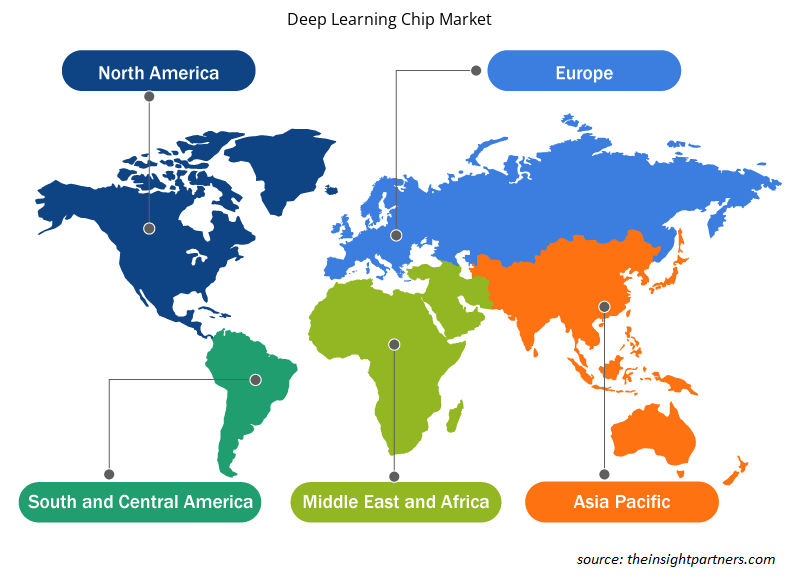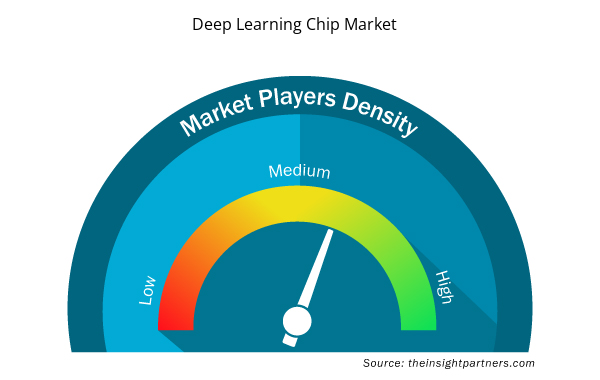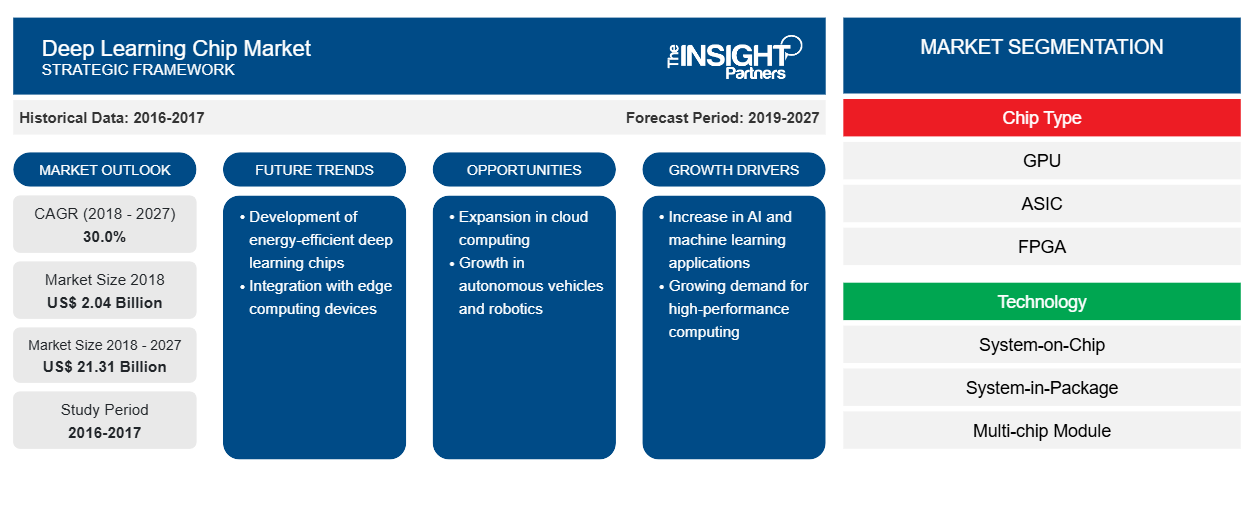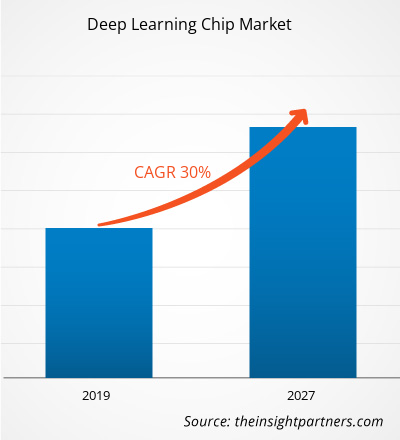Il mercato globale dei chip per l'apprendimento profondo ha rappresentato 2,04 miliardi di dollari nel 2018 e si prevede che crescerà a un CAGR del 30,0% nel periodo di previsione 2019-2027, fino a raggiungere i 21,31 miliardi di dollari entro il 2027.
Il Nord America guida il mercato globale dei chip per deep learning e si prevede che sarà il maggiore contributore di fatturato per tutto il periodo di previsione. Lo sviluppo dei chip per deep learning è sostenuto da investimenti su larga scala da parte di giganti della tecnologia per sviluppare modelli da un'enorme quantità di dati generati. L'ascesa del calcolo quantistico e l'implementazione di chip per deep learning nella robotica stanno guidando la crescita del mercato dei chip per deep learning nei paesi del Nord America.
Approfondimenti di mercato
L'importanza del Quantum Computing contribuisce alla crescita del mercato dei chip per l'apprendimento profondo
Il calcolo quantistico impiega pochi secondi per completare un calcolo che altrimenti richiederebbe più tempo. I computer quantistici sono una trasformazione innovativa dell'intelligenza artificiale, dell'apprendimento automatico e dei big data. Pertanto, si prevede che l'importanza del calcolo quantistico guiderà la crescita del mercato dei chip per l'apprendimento profondo. Inoltre, il calcolo quantistico è vantaggioso per vari fattori, tra cui l'ottimizzazione del portafoglio, il rilevamento delle frodi e la gestione del rischio, e le aree in cui è richiesto un feedback immediato sui dati. Pertanto, è più facile per un singolo processore eseguire calcoli complessi in pochi secondi. Inoltre, con la scala e le dimensioni di Internet , il deep learning aiuta a mantenere grandi set di dati a un costo molto basso. Quindi, si prevede che questi fattori stimoleranno la crescita del mercato globale dei chip per l'apprendimento profondo
Personalizza questo report in base alle tue esigenze
Riceverai la personalizzazione gratuita di qualsiasi report, comprese parti di questo report, o analisi a livello nazionale, pacchetto dati Excel, oltre a usufruire di grandi offerte e sconti per start-up e università
- Scopri le principali tendenze di mercato in questo rapporto.Questo campione GRATUITO includerà analisi di dati che spaziano dalle tendenze di mercato alle stime e alle previsioni.
Informazioni in tempo reale sul comportamento dei consumatori e maggiore efficienza operativa per promuovere la crescita complessiva del mercato dei chip di apprendimento profondo
La natura del business sta diventando molto competitiva e per competere in modo efficiente, le aziende oggigiorno si affidano a informazioni utili e analisi aziendali. Tradizionalmente, gli strumenti di analisi aziendale venivano utilizzati per proiettare le vendite dai dati sugli eventi che risalivano a una settimana o un mese fa. Con l'avvento della tecnologia di intelligenza artificiale che apprende in tempo reale e fornisce raccomandazioni basate su modelli, le aziende hanno una straordinaria opportunità di applicare l'apprendimento profondo in vari processi per comprendere meglio l'ambiente aziendale e i clienti.
Considerando questi fattori, l'intelligenza artificiale consente alle aziende di migliorare l'efficienza operativa, ridurre i costi operativi e potenziare la qualità del servizio e l'esperienza del cliente.
Informazioni sul tipo di chip
Le unità di elaborazione grafica (GPU) hanno detenuto la quota di mercato maggiore dei chip di apprendimento profondo nel 2018, mentre si prevede che gli Application-Specific Integrated Circuits (ASIC) saranno il segmento in più rapida crescita durante il periodo di previsione. A causa del fattore che gli ASIC sono molto specifici e meno flessibili, ma sono una delle opzioni hardware più performanti disponibili per le applicazioni di intelligenza artificiale.
Approfondimenti tecnologici
I chipset di deep learning includono system-on-chip, system-in-package, multi-chip module e altri, e altri chipset. Il segmento system-on-chip ha detenuto la quota di mercato maggiore dei chip di deep learning nel 2018, in quanto aiuta a ridurre lo spreco di energia, lo spazio occupato dai grandi sistemi e i costi.
Approfondimenti verticali del settore
Il mercato globale dei chip per deep learning è suddiviso in BFSI, Retail, IT e Telecom, Automotive e Trasporti, Sanità, Media e Intrattenimento e Altri. BFSI deteneva la quota di mercato maggiore nel mercato dei chip per deep learning, mentre si prevede che l'assistenza sanitaria sarà il segmento in più rapida crescita nel mercato. Fattori come la riduzione dei costi operativi, l'adattamento alle mutevoli conformità e normative, la focalizzazione sul core business e l'integrazione dell'automazione nei processi aziendali sono altri fattori importanti che stanno alimentando la crescita del segmento BFSI nel mercato dei chip per deep learning
Gli attori del mercato presenti nel mercato dei chip per deep learning si stanno concentrando principalmente sui miglioramenti dei prodotti implementando tecnologie avanzate. Firmando partnership, contratti, joint venture, finanziamenti e inaugurando nuovi uffici in tutto il mondo, l'azienda può mantenere il suo marchio a livello globale. Di seguito sono elencati alcuni degli sviluppi recenti;
2019: NVIDIA ha stretto una partnership con Hackster.io per lanciare l'AI at the Edge Challenge, una competizione in cui gli sviluppatori utilizzano l'NVIDIA Jetson Nano Developer Kit per realizzare progetti creativi e unici e hanno la possibilità di vincere premi del valore di 100.000 dollari.
2019: Intel ha annunciato i suoi piani per espandere la fabbrica dell'Oregon per produrre un chip da 7 nm. La nuova fabbrica di Intel sarà la terza fase di D1X, una fabbrica enorme che Intel ha avviato nel 2010. Ognuna delle prime due fasi era di 1,1 milioni di piedi quadrati, creando una struttura combinata equivalente a 15 magazzini Costco. La terza fase aumenterà apparentemente lo spazio di produzione di D1X di circa il 50 percento. Inoltre, Intel afferma che l'espansione della sua fabbrica le consentirà di rispondere il 60 percento più velocemente alle carenze di chip.
2019: Huawei ha lanciato HiSecEngine USG12000, il primo AIFW T-level del settore. HiSecEngine USG12000 è dotato di chip Ascend AI, che forniscono capacità di rilevamento intelligenti e difesa intelligente dei confini per le reti aziendali.
Approfondimenti regionali sul mercato dei chip per l'apprendimento profondo
Le tendenze regionali e i fattori che influenzano il mercato dei chip per l'apprendimento profondo durante il periodo di previsione sono stati ampiamente spiegati dagli analisti di Insight Partners. Questa sezione discute anche i segmenti e la geografia del mercato dei chip per l'apprendimento profondo in Nord America, Europa, Asia Pacifico, Medio Oriente e Africa e America meridionale e centrale.

- Ottieni i dati specifici regionali per il mercato dei chip di apprendimento profondo
Ambito del rapporto sul mercato dei chip di apprendimento profondo
| Attributo del report | Dettagli |
|---|---|
| Dimensioni del mercato nel 2018 | 2,04 miliardi di dollari USA |
| Dimensioni del mercato entro il 2027 | 21,31 miliardi di dollari USA |
| CAGR globale (2018 - 2027) | 30,0% |
| Dati storici | 2016-2017 |
| Periodo di previsione | 2019-2027 |
| Segmenti coperti | Per tipo di chip
|
| Regioni e Paesi coperti | America del Nord
|
| Leader di mercato e profili aziendali chiave |
|
Densità degli attori del mercato: comprendere il suo impatto sulle dinamiche aziendali
Il mercato dei chip per il deep learning sta crescendo rapidamente, spinto dalla crescente domanda degli utenti finali dovuta a fattori quali l'evoluzione delle preferenze dei consumatori, i progressi tecnologici e una maggiore consapevolezza dei vantaggi del prodotto. Con l'aumento della domanda, le aziende stanno ampliando le loro offerte, innovando per soddisfare le esigenze dei consumatori e capitalizzando sulle tendenze emergenti, il che alimenta ulteriormente la crescita del mercato.
La densità degli operatori di mercato si riferisce alla distribuzione di aziende o società che operano in un particolare mercato o settore. Indica quanti concorrenti (operatori di mercato) sono presenti in un dato spazio di mercato in relazione alle sue dimensioni o al valore di mercato totale.
Le principali aziende che operano nel mercato dei chip per il deep learning sono:
- Dispositivi Micro avanzati
- Alfabeto Inc. (Google)
- Amazon.com, Inc.
- Baidu, Inc.
- Società Huawei Technologies Co., Ltd.
Disclaimer : le aziende elencate sopra non sono classificate secondo un ordine particolare.

- Ottieni una panoramica dei principali attori del mercato dei chip per l'apprendimento profondo
SEGMENTAZIONE DEL MERCATO GLOBALE DEI CHIP DI APPRENDIMENTO PROFONDO
Per tipo di chip
- Scheda grafica
- ASIC
- FPGA
- processore
- Altri
Per tecnologia
- Sistema su chip
- Sistema nel pacchetto
- Modulo multi-chip
- Altri
Per settore verticale
- Media e pubblicità
- BFSI, IT e telecomunicazioni
- Vedere al dettaglio
- Assistenza sanitaria
- Automotive e trasporti
- Altri
Per Geografia
America del Nord
- NOI
- Canada
- Messico
Europa
- Francia
- Germania
- Regno Unito
- Russia
- Italia
- Resto d'Europa
Asia Pacifico (APAC)
- Australia
- Cina
- India
- Giappone
- Corea del Sud
- Resto dell'APAC
Medio Oriente e Africa (MEA)
- Arabia Saudita
- Sudafrica
- Emirati Arabi Uniti
- Resto del MEA
America del Sud (SAM)
- Brasile
- Argentina
- Resto del SAM
Profili aziendali
- Dispositivi Micro avanzati
- Alfabeto Inc. (Google)
- Amazon.com, Inc.
- Baidu, Inc.
- Società Huawei Technologies Co., Ltd.
- Società Intel
- Società NVIDIA
- Qualcomm Incorporata
- Samsung Electronics Co., Ltd.
- Società anonima
- Analisi storica (2 anni), anno base, previsione (7 anni) con CAGR
- Analisi PEST e SWOT
- Valore/volume delle dimensioni del mercato - Globale, regionale, nazionale
- Industria e panorama competitivo
- Set di dati Excel


- Predictive Maintenance Market
- Excimer & Femtosecond Ophthalmic Lasers Market
- Latent TB Detection Market
- Portable Power Station Market
- Smart Mining Market
- Health Economics and Outcome Research (HEOR) Services Market
- Analog-to-Digital Converter Market
- Medical and Research Grade Collagen Market
- Industrial Valves Market
- Adaptive Traffic Control System Market

Report Coverage
Revenue forecast, Company Analysis, Industry landscape, Growth factors, and Trends

Segment Covered
This text is related
to segments covered.

Regional Scope
North America, Europe, Asia Pacific, Middle East & Africa, South & Central America

Country Scope
This text is related
to country scope.
Domande frequenti
The BFSI industry dominated the deep learning chip market in the year 2018. Banking, financial services, and insurance (BFSI) industries have great potential for deep learning chips due to the presence of huge financial and personal data of customers. In this sector, a high amount of sensitive data is generated and exchanged every day. There is growing volume and creation of endpoints and mobile devices in banks, credit card companies, and credit reporting institutions, thus, it becomes important for these industry verticals to harness this data to gain insights about various business aspects.
Presently, the major applications of deep learning chips are in the data center/cloud computing segment, and this trend is expected to continue during the forecast period. Also, majorly due to rising adoption of AI in developing regions, evolving architectures of deep learning chips and increasing applications across various industry verticals. Owing to this growing trend, the companies are anticipated to produce high-quality service by adopting cloud-based artificial intelligence services.
North America is one of the fastest-growing regions in terms of technological development. In the past 3 years, the region witnessed significant adoption of AI solutions across all the sectors. North America contributes the largest market share in terms of revenue, and it is estimated that it will continue its dominance in the market share during the forecast period. Deep learning chip development is backed by large-scale investment from technological giants to develop patterns from huge amount of generated data. The rise of quantum computing and implementation of deep learning chips in robotics drive the growth of the deep learning chip market in the North American countries.
Trends and growth analysis reports related to Electronics and Semiconductor : READ MORE..
The List of Companies - Deep Learning Chip Market
- Advanced Micro Devices, Inc.
- Alphabet Inc. (Google)
- Amazon.com, Inc.
- Baidu, Inc.
- Huawei Technologies Co., Ltd
- Intel Corporation
- NVIDIA Corporation
- Qualcomm Incorporated
- Samsung Electronics Co., Ltd.
- Xilinx, Inc.
The Insight Partners performs research in 4 major stages: Data Collection & Secondary Research, Primary Research, Data Analysis and Data Triangulation & Final Review.
- Data Collection and Secondary Research:
As a market research and consulting firm operating from a decade, we have published and advised several client across the globe. First step for any study will start with an assessment of currently available data and insights from existing reports. Further, historical and current market information is collected from Investor Presentations, Annual Reports, SEC Filings, etc., and other information related to company’s performance and market positioning are gathered from Paid Databases (Factiva, Hoovers, and Reuters) and various other publications available in public domain.
Several associations trade associates, technical forums, institutes, societies and organization are accessed to gain technical as well as market related insights through their publications such as research papers, blogs and press releases related to the studies are referred to get cues about the market. Further, white papers, journals, magazines, and other news articles published in last 3 years are scrutinized and analyzed to understand the current market trends.
- Primary Research:
The primarily interview analysis comprise of data obtained from industry participants interview and answers to survey questions gathered by in-house primary team.
For primary research, interviews are conducted with industry experts/CEOs/Marketing Managers/VPs/Subject Matter Experts from both demand and supply side to get a 360-degree view of the market. The primary team conducts several interviews based on the complexity of the markets to understand the various market trends and dynamics which makes research more credible and precise.
A typical research interview fulfils the following functions:
- Provides first-hand information on the market size, market trends, growth trends, competitive landscape, and outlook
- Validates and strengthens in-house secondary research findings
- Develops the analysis team’s expertise and market understanding
Primary research involves email interactions and telephone interviews for each market, category, segment, and sub-segment across geographies. The participants who typically take part in such a process include, but are not limited to:
- Industry participants: VPs, business development managers, market intelligence managers and national sales managers
- Outside experts: Valuation experts, research analysts and key opinion leaders specializing in the electronics and semiconductor industry.
Below is the breakup of our primary respondents by company, designation, and region:

Once we receive the confirmation from primary research sources or primary respondents, we finalize the base year market estimation and forecast the data as per the macroeconomic and microeconomic factors assessed during data collection.
- Data Analysis:
Once data is validated through both secondary as well as primary respondents, we finalize the market estimations by hypothesis formulation and factor analysis at regional and country level.
- Macro-Economic Factor Analysis:
We analyse macroeconomic indicators such the gross domestic product (GDP), increase in the demand for goods and services across industries, technological advancement, regional economic growth, governmental policies, the influence of COVID-19, PEST analysis, and other aspects. This analysis aids in setting benchmarks for various nations/regions and approximating market splits. Additionally, the general trend of the aforementioned components aid in determining the market's development possibilities.
- Country Level Data:
Various factors that are especially aligned to the country are taken into account to determine the market size for a certain area and country, including the presence of vendors, such as headquarters and offices, the country's GDP, demand patterns, and industry growth. To comprehend the market dynamics for the nation, a number of growth variables, inhibitors, application areas, and current market trends are researched. The aforementioned elements aid in determining the country's overall market's growth potential.
- Company Profile:
The “Table of Contents” is formulated by listing and analyzing more than 25 - 30 companies operating in the market ecosystem across geographies. However, we profile only 10 companies as a standard practice in our syndicate reports. These 10 companies comprise leading, emerging, and regional players. Nonetheless, our analysis is not restricted to the 10 listed companies, we also analyze other companies present in the market to develop a holistic view and understand the prevailing trends. The “Company Profiles” section in the report covers key facts, business description, products & services, financial information, SWOT analysis, and key developments. The financial information presented is extracted from the annual reports and official documents of the publicly listed companies. Upon collecting the information for the sections of respective companies, we verify them via various primary sources and then compile the data in respective company profiles. The company level information helps us in deriving the base number as well as in forecasting the market size.
- Developing Base Number:
Aggregation of sales statistics (2020-2022) and macro-economic factor, and other secondary and primary research insights are utilized to arrive at base number and related market shares for 2022. The data gaps are identified in this step and relevant market data is analyzed, collected from paid primary interviews or databases. On finalizing the base year market size, forecasts are developed on the basis of macro-economic, industry and market growth factors and company level analysis.
- Data Triangulation and Final Review:
The market findings and base year market size calculations are validated from supply as well as demand side. Demand side validations are based on macro-economic factor analysis and benchmarks for respective regions and countries. In case of supply side validations, revenues of major companies are estimated (in case not available) based on industry benchmark, approximate number of employees, product portfolio, and primary interviews revenues are gathered. Further revenue from target product/service segment is assessed to avoid overshooting of market statistics. In case of heavy deviations between supply and demand side values, all thes steps are repeated to achieve synchronization.
We follow an iterative model, wherein we share our research findings with Subject Matter Experts (SME’s) and Key Opinion Leaders (KOLs) until consensus view of the market is not formulated – this model negates any drastic deviation in the opinions of experts. Only validated and universally acceptable research findings are quoted in our reports.
We have important check points that we use to validate our research findings – which we call – data triangulation, where we validate the information, we generate from secondary sources with primary interviews and then we re-validate with our internal data bases and Subject matter experts. This comprehensive model enables us to deliver high quality, reliable data in shortest possible time.


 Ottieni un campione gratuito per questo repot
Ottieni un campione gratuito per questo repot